PALMAE. Small, hardy, bushy desert palms.
—Nannorrhops Ritchiana. (10) NANN-21. Packet: $4.00
'MAZARI PALM'. Clumping multi-stemmed palm to 10 feet or more, with pinnate 6 foot fronds and orange fruits. Afghanistan, Iran, India, in dry cold regions. Zone 8. Needs heat to germinate over a long period.
NELUMBO (ne-LUM-bo)
NELUMBONACEAE. Large, strong-growing aquatic plants with large round leaves held above the water, and huge flowers followed by ornamental flat-topped seed pods used in dried arrangements. Good in large ponds and shallow water where the tubers will be out of reach of frost. Can be grown in large tubs. File through outer layer of seed coat (not to the quick) and soak in water. In a few days to a week they will swell and float (in nature dispersing them), then they sink and shoots emerge in about 10 - 15 days. Plant in pots or weight with clay and drop in a pond. Seed viable 150 to 1000 years.
—Nelumbo nucifera. (10) NELU-17. Packet: $3.00
1/4 Pound: $40.00 (about 125 seed)
'HINDU LOTUS', 'SACRED LOTUS'. Fragrant pink or rose flowers 4 - 10" across. Round leaves 1 - 3 feet across, held 3 - 6 feet above the water. Ornamental seed pods. S. Asia. Zone 8. The flower is held sacred throughout the East, being the symbol of the world, its wheel-like form representing the eternal cycles of existence. Deities are often represented seated upon its center, and in China it is the symbol of purity, truth, and summer. The seeds are eaten raw, roasted or boiled and are said to taste like filberts or pine-nuts. The roots are eaten sliced, pickled in salt and vinegar, or pounded for starch. The tender root-shoots are eaten boiled, and the stems are eaten in Japan, and are said to taste like beets. The petals are used in soups and the stamens for flavoring tea. The leaves are used as plates, and all parts are valued in Chinese medicine.
NEW—Nelumbo nucifera White. (10) NELU-17W. Packet: $3.00
1/4 pound: $40.00
'WHITE SACRED LOTUS'. The white flowered form, with large fragrant flowers. Unusual.
Click for photos on how to germinate Nelumbo »
Step 1, Use a file:


Proper amount of nicking:

Soaking the seed:
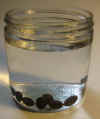
And a week or ten days later, they sprout:
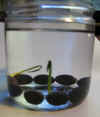 Voila!
Voila!NEMESIA (ne-MEE-see-a)
SCROPHULARIACEAE. Showy, easily grown tender annuals and perennials grown for their profusion of brilliant, two-lipped, tubular, spurred flowers. If started indoors in March and planted out in May 4 - 6" apart, they will smother themselves with bloom from June to September. Best in sunny, sheltered places; they do not like excessive heat. Blooms best in cool weather. Excellent for cut flowers or winter blooming pot plants. Good for bedding, borders, containers and bulb cover. Germinates in 1 - 3 weeks at cool temperatures. Seed half-life is 2 - 6 years.
—Nemesia Tetra Carnival Mixture. (1000) NEME-6C. Packet: $2.50
5 grams: $7.50
25 grams: $28.00
Brilliant shades of red, pink, bronze, cream, lavender, orange and white. To 8". Makes a stunning display planted in masses, A rich mixture.
NEMOPHILA (ne-MO-fee-la)
HYDROPHYLLACEAE. Showy, low-growing annuals valued for their bright, abundant, bell-shaped flowers. Good for naturalizing, they are best in masses. Continuous bloom from spring through summer. Sun or part shade, ordinary soil, moderate water. Easy from seed, sow where they are to grow.
—Nemophila Menziesii. (500) NEMO-16. Packet: $2.00 OUT OF STOCK
Ounce: $6.00 OUT OF STOCK
1/4 Pound: $18.00 OUT OF STOCK
Click for photo »

'BABY BLUE EYES'. Bright blue 1 1/2" flowers with white centers, blooming abundantly over a long period. Low annual to 10". California. Nice for edging, borders or sown in drifts. Drought resistant. Germinates in 1 - 2 weeks at cool temperatures.
NEPETA (NE-pe-ta)
LABIATAE. Aromatic annuals and perennials with pretty blue or white flowers. Easily grown in most soils, sun or shade. Sow where they are to stand. Seed viable 5 years.
—Nepeta Cataria. (1000) NEPE-3. Packet: $2.50
Ounce: $7.50
1/4 Pound: $25.00
'CATNIP'. Dense whorls of small white or pinkish flowers, July to November. Hardy perennial to 3 feet; with downy, heart-shaped 3" leaves. Eurasia. Zone 3. Well-known cat attractant due to feline sex-pheromones. Said to repel rats. Good bee plant. Makes a nice tea and the young shoots are used in French cooking. Germinates irregularly in 1 - 4 weeks and up, best in light.
NEW—Nepeta Cataria citriodora. (500) NEPE-3C. Packet: $2.50
Gram: $7.50
'LEMON CATNIP'. A lemon-scented variety. Prechill seed 4 - 8 weeks to germinate in 6 weeks and up.
NICANDRA (nee-KAN-dra)
SOLANACEAE. A single species. Grow like tomatoes, likes full sun and ordinary soil, but stands part shade. Space 1 - 3 feet apart. Good in pots. Flowers in about 14 weeks from seed and for 12 weeks more. Aged seed sprouts readily, fresh seed needs cold or GA-3.
—Nicandra Physalodes. (500) NICA-1. Packet: $2.50
25 grams: $14.00
100 grams: $30.00
Click for photo »

'SHOO-FLY PLANT', 'APPLE OF PERU'. Sky-blue, inch-wide bells all summer, followed by attractive, unusual papery, five-winged pods which are useful in dried arrangements. Vigorous bushy half hardy annual to 2 - 5 feet tall, with light green, wavy-edged leaves. Peru. An old-fashioned garden favorite, grown for ornament and its fly-killing or repelling properties, which many people swear by. Formerly much grown around farm houses for this purpose. Also grown in greenhouses as it attracts and kills white flies. Give GA-3.
—Nicandra Physalodes var. nigra. (500) NICA-1N. Packet: $2.50
Ounce: $12.00
Deep purple-black stems and pods flushed purple. Sky blue inch-wide flowers. Use GA-3 to germinate in a week.
NICOTIANA (ni-KO-she-A-na or NI-ko-tee-A-na)
SOLANACEAE. Nearly 70 species of herbs to small trees, mostly Western Hemisphere, but 20 in Australia and 1 in SW Africa. Valued for their often showy, mostly fragrant trumpet shaped flowers, and the bold effect of the foliage. Excellent in borders, preferring rich moist soil and full sun. Fragrant types may be flowered in pots for indoor scent. Many species have been smoked, and several are grown for the production of the valuable biodegradable insecticide nicotine. Sow indoors a month or two before last frost or outdoors when the weather has warmed. Surface sow, most germinate in 1 - 3 weeks. Seed long-lived, with a half-life of 5 - 10 years.
—Nicotiana acuminata v. multiflora. (1000) NICO-2. Packet: $2.50
5 grams: $7.50
White trumpets in summer on a graceful annual to 6 feet, with pointed leaves. Chile. Attractive in masses. NOTE: Formerly offered as N. Bigelovii, a case of grower mis-identification.
—Nicotiana alata 'Sensation Mix'. (1000) NICO-3SX. Packet: $2.50
Ounce: $11.00
1/4 pound: $30.00 1/4 pound Unit OUT OF STOCK - packets and ounces are still available
'JASMINE TOBACCO'. Intensely fragrant trumpets in shades of deep red, yellow, white, purple, and soft pink. Flowers are open all day and release their fragrance at dusk. Plant near a window for heavenly fragrance on summer evenings. Tender perennial to 3 feet. Likes sun and well-drained soil. Good cut flowers. Attracts hummingbirds and beneficial insects.
—Nicotiana alata 'Sweet Scented White'. (1000) NICO-3W. Packet: $2.50
10 grams: $6.00
25 grams: $10.00
100 grams: $28.00
Click for photos »



'JASMINE TOBACCO'. Very sweet scented pure white trumpet-shaped flowers 3 - 4" long and 1 - 2" wide. Tender perennial to 3 - 4 feet, usually grown as an annual. Brazil. Popular and free blooming. "Fall sown seedlings make excellent pot plants in winter... and are very fragrant."—Ricker. This is the true old-fashioned type, tall and intensely fragrant.
—Nicotiana benavidesii. (100) NICO-7. Packet: $7.00
Yellow-green tubular 1 1/2" flowers on a thick-stemmed perennial to 5 feet, with bright green heart-shaped leaves. From 7600 feet in dry forest near the Apurimac. Zone 10. "Young plants develop a distinct pachycaul stem. Should tolerate hot dry conditions well."—Kamm. Germinates in 1 - 2 weeks.
—Nicotiana glauca. (=arborea) (100) NICO-15. Packet: $2.50
Click for photos »
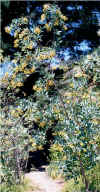

'TREE TOBACCO', 'DON JUAN', 'ISIL-PIVAT' (Cahuilla Indian name). Bright yellow, tubular shaped 1 1/2" flowers in large, pendant clusters. Graceful tree or shrub to 20 feet, with striking glaucous-blue foliage. Argentina. Grown outdoors in the Southwest, or as a stately tub plant in the North. Sometimes grown as an annual in the border for the bold foliage. Valued by Indians for smoking, chewing, drinking, and medicinal uses. Said to contain only trace nicotine, its major alkaloid is anabasine, which is similar in action, but a bit less toxic. Highly toxic to aphids. Hardy to about 15°F. I have had it flower in a 3" pot when 1 foot tall. Attracts hummingbirds and sphinx moths. Fresh seed often dormant, and needs GA-3, but seed a year or two old germinates readily in 1 - 2 weeks.
—Nicotiana Langsdorfii 'Lemon Tree'. (1000) NIC0-20L. Packet $2.50
5 grams: $7.50
Nodding greenish yellow 1 1/2" flowers in large branching sprays. Hardy annual to 3 - 4 feet. Brazil and Chile. Germinates in 2 - 4 weeks. seeds and plants grown by plant-explorer Ben Kamm, including many Andean rarities, see his website at www.sacredsucculents.com
—Nicotiana rustica 'Rapa Nui'. (500) NICO-29RN. Packet: $2.50
Click for photos »
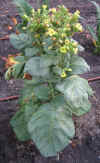

'AVA-AVA', 'EASTER ISLAND TOBACCO'. Yellow flowers and 15" long leaves, on a plant to 3 - 4 feet. Originally collected on Rapa Nui (Easter Island), where the local indigenous cowboys call it 'ava-ava' and smoke it mixed with milder commercial tobacco or with Can nabis. They say it has always been on the island (not introduced). They say it is very strong-flavored. Curiously, 'ava-ava' is used elsewhere in the South Pacific to refer to the intoxicating drink 'kava'. Germinates in 1 - 2 weeks.
—Nicotiana rustica 'San Juan Pueblo'. (1000) NICO-29SJ. Packet: $2.50
Traditionally grown variety from the San Juan Pueblo. Used ceremonially. Germinates in 1 - 3 weeks.
—Nicotiana sylvestris. (1000) NICO-33. Packet: $2.50
10 grams: $15.00
100 grams: $100.00
Click for photos »
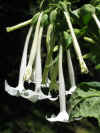
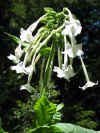
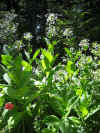
Sweet scented drooping white flowers with long slender tubes flaring to 1 - 2" wide. Vigorous tender perennial to 5 - 8 feet, with large 20" basal leaves, making bold attractive clumps. Argentina. On a warm summer evening a clump will perfume a yard with one of the most delightful scents I've known.
NIGELLA (ni-JELL-la)
RANUNCULACEAE. Showy, easily grown hardy annuals. White, blue or yellow flowers followed by interesting inflated pods. The leaves are delicate and finely divided. Sow from March onwards outdoors in a sunny place, and they will give much bloom for little care. In warm areas you can sow in fall. Makes good cut flowers and the dried pods are ornamental. Succession sowing extends bloom. Germinates in 1 - 4 weeks.
—Nigella damascena 'Red Pod'. (250) NIG-3RP. Packet: $2.50
10 grams: $7.50
Large white flowers followed by red seed pods, good in dried arrangements. Hardy annual to 2 feet, with lacy foliage. Very nice! Germinates in 1 - 2 weeks.
—Nigella hispanica. (250) NIG-5. Packet: $2.50
10 grams: $7.50
'SPANISH FENNELFLOWER'. Blue 2 1/2" flowers with dark centers and reddish stamens. Hardy annual to 1 1/2 - 2 feet, with divided leaves and attractive pods. Spain and N. Africa.
—Nigella sativa. (200) NIG-22. Packet: $2.50
'NUTMEG FLOWER', 'BLACK CUMIN', 'ROMAN CORIANDER'. White or blue 1 1/2" flowers followed by odd inflated pods. Branched annual to about 12", with divided leaves. E. Mediterranean. The aromatic seeds are used as seasoning in the Mediterranean, Middle East and India. Commonly used in curries, on bread and cakes. Called 'Four-Spice' in France, it is described as having a lemon-carrot scent. Also medicinal, and placed among clothes to repel insects. Germinates in 1 - 3 weeks.